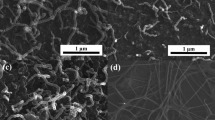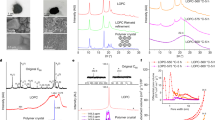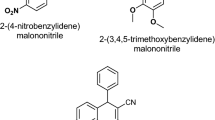Abstract
Carbon materials have many attractive physical and chemical properties, because of a wide variety of chemical bonding, crystal structure and microtexture. Carbon properties can be created by selecting a preparation procedure and a raw material. For example, many new carbon materials such as exfoliated graphite, benzenederived fibre and diamond film have come into use recently. The possibility of creating a new carbon material by a new method still remains. Here we report a novel method of preparing a highly orientated graphite from polyacrylonitrile (PAN) by making use of the interlamellar opening of montmorillonite (MONT) as a two-dimensional space for carbonization. A MONT-PAN intercalation compound was prepared and heat-treated at 700 °C to produce carbon from PAN between MONT lamellae. The carbon was then released from MONT by acid treatment and subjected to further heat treatment at various temperatures up to 2,800°C. The interplanar spacing (d002) of the carbon treated at 2,800 °C was very close to that of ideal graphite crystal and the crystallite size, Lc and La, were ~40 nm and >1μm, respectively. The formation of such a highly orientated carbon is probably a consequence of the orientation of the two-dimensional carbon precursor produced between the lamellae of MONT. When PAN itself is heat-treated, it produces a three-dimensional carbon with a network of intertwined ribbons of stacked graphitic sheets.
This is a preview of subscription content, access via your institution
Access options
Subscribe to this journal
Receive 51 print issues and online access
$199.00 per year
only $3.90 per issue
Buy this article
- Purchase on Springer Link
- Instant access to full article PDF
Prices may be subject to local taxes which are calculated during checkout
Similar content being viewed by others
References
Murakami, M., Yoshimura, S. & Iijima, S. Appl. Phys. Lett. 48, 390–393 (1986).
Murakami, M., Watanabe, K. & Yoshimura, S. Appl. Phys. Lett. 48, 1594–1596 (1986).
Ohnishi, T., Murase, I., Noguchi, T. & Hirooka, M. Synth. Met. 14, 207–213 (1986).
Yamanaka, S., Kanamaru, F. & Koizumi, M. J. phys. Chem. 78, 42–44 (1974).
Blumstein, R., Blumstein, A. & Parikh, K. K. Appl. Polymer Symp. 25, 81–88 (1974).
Jenkins, G. M. & Kawamura, K. Polymeric Carbons 65–73 (Cambridge University Press, 1976).
Author information
Authors and Affiliations
Rights and permissions
About this article
Cite this article
Kyotani, T., Sonobe, N. & Tomita, A. Formation of highly orientated graphite from polyacrylonitrile by using a two-dimensional space between montmorillonite lamellae. Nature 331, 331–333 (1988). https://doi.org/10.1038/331331a0
Received:
Accepted:
Issue Date:
DOI: https://doi.org/10.1038/331331a0
This article is cited by
-
Carbon gels with tuned properties for catalysis and energy storage
Journal of Sol-Gel Science and Technology (2019)
-
A general synthetic strategy to monolayer graphene
Nano Research (2018)
-
Versatile Molding Process for Tough Cellulose Hydrogel Materials
Scientific Reports (2015)
-
Controllable synthesis and capacitive performance of nitrogen-doped porous carbon from carboxymethyl chitosan by template carbonization method
Journal of Solid State Electrochemistry (2015)
-
A multi-template carbonization approach to hierarchically nanoporous carbon for high-performance supercapacitors
Journal of Solid State Electrochemistry (2015)
Comments
By submitting a comment you agree to abide by our Terms and Community Guidelines. If you find something abusive or that does not comply with our terms or guidelines please flag it as inappropriate.



